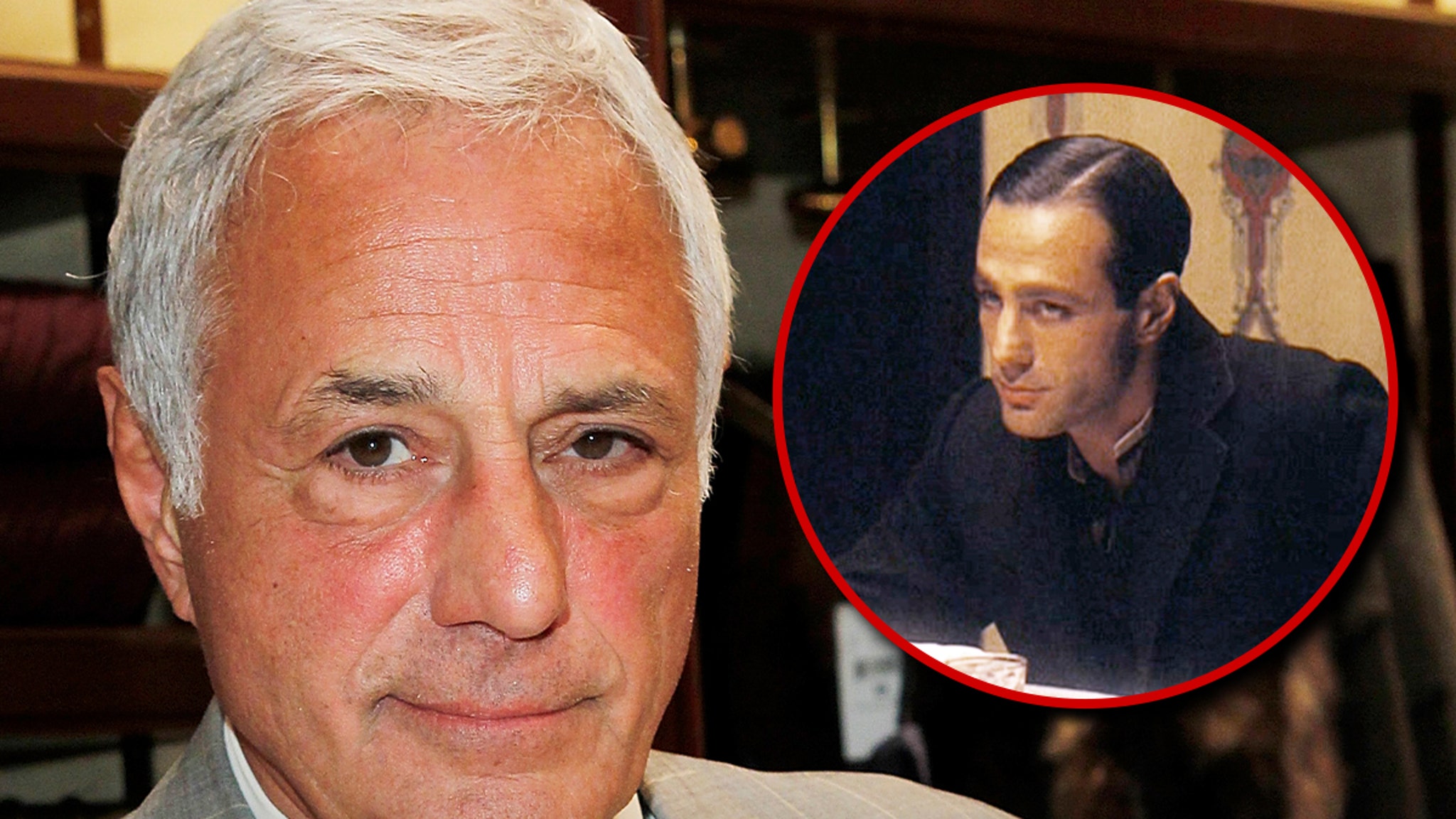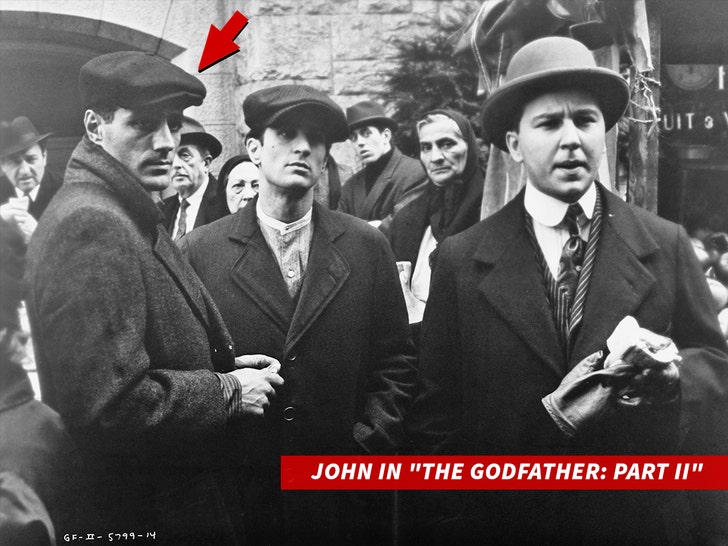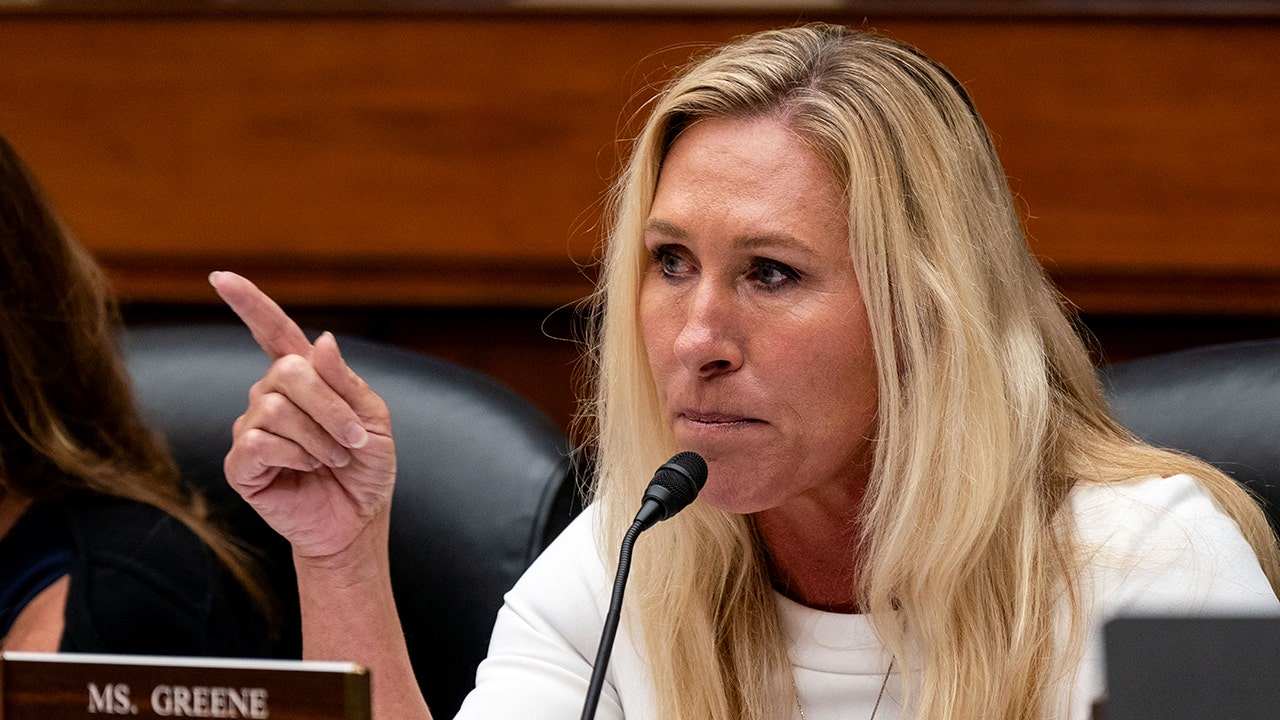Lifestyle
'Godfather Part II' Star John Aprea Dead at 83

John Aprea, one of the stars of “The Godfather Part II” and “Full House,” is dead of natural causes … TMZ has learned.

His manager Will Levine tells us … the actor passed away on August 7, at his home in Los Angeles, with family members by his side.
John called his role as young Salvatore Tessio his greatest career achievement. He had originally auditioned to be Michael Corleone in the OG ‘Godfather,’ which of course went to Al Pacino. But, Francis Ford Coppola called back Aprea for the 1974 sequel.

John’s successful career actually started with another classic, as he made his acting debut in 1968 in Steve McQueen‘s “Bullitt.”
In the ’80s and ’90s he appeared on several TV shows, including “Knots Landing,” “Falcon Crest,” “The Gangster Chronicles” and “Full House” — how’s that for range?!

Aprea played Nick Katsopolis, the father of John Stamos‘ Uncle Jesse character — and he returned in that role for the reboot, “Fuller House.”
He had a couple of stints in Daytime TV, too, appearing on “Another World” for several years in 2 different roles.
Waiting for your permission to load the Instagram Media.
His friend and former “Knots Landing” costar Paul Carafotes posted a touching tribute to Aprea, saying “Many will miss this man.”
John was 83.
RIP

Lifestyle
'The Bachelor,' Ukraine edition, features a veteran who lost both legs in the war

Oleksandr Budko, a 28-year-old Ukrainian war veteran, whose military call sign is Teren, poses for a portrait in Kyiv, Ukraine, on Oct. 18. Budko, a double amputee, participated in the Ukrainian version of the TV show The Bachelor.
Oksana Parafeniuk for NPR
hide caption
toggle caption
Oksana Parafeniuk for NPR
KYIV, Ukraine — Oleksandr Budko looks like a leading man. He’s sandy-haired and blue-eyed, with muscular tattooed arms and the chiseled face of a movie star.
“I’m a military veteran, an activist and writer. And I’m also The Bachelor,” he says in this season’s Ukrainian edition of the popular reality TV franchise.
The Bachelor, or Kholostiak in Ukrainian, is produced by Starlight Media and Warner Bros. International Television, and it airs on STB, a Ukrainian channel. This season, its 13th, premiered on Nov. 1.

Inna Bielien, 29, a German language translator, poses for a portrait at home in Kyiv, Ukraine, on Dec. 13. She is one of the female contestant of the Ukrainian version of the TV show The Bachelor.
Oksana Parafeniuk for NPR
hide caption
toggle caption
Oksana Parafeniuk for NPR
In one episode, Budko is on a rock-climbing date with a wholesome translator named Inna Bielien.
“Oh my God,” she says, as she hangs off the cliff.
“Don’t worry, I will be very close, right behind you,” he says, as he helps her scale the rock face.
What goes unsaid is that Budko is doing this on prosthetic legs, clearly visible because he’s wearing shorts. He’s a double amputee. He represents the tens of thousands of Ukrainians who have lost limbs since Russia’s 2022 invasion of Ukraine. An adviser to Ukraine’s Sports and Youth Ministry put the number at around 100,000 last year.

Oleksandr Budko, with the call sign Teren, lost both legs on the front line in Ukraine’s battle against the Russian invasion.
Oksana Parafeniuk for NPR
hide caption
toggle caption
Oksana Parafeniuk for NPR
Their visibility — in fashion magazines, on catwalks and now a popular reality TV series — shows how much the war has affected Ukraine.
“Still,” he tells NPR in an interview, “there is still a problem with stigma. I went on The Bachelor to help address it.”
“I realized then I would lose my legs”
Budko, 28, grew up in western Ukraine and was working as a barista in a coffeeshop in Kyiv when Russia launched its full-scale invasion of Ukraine in February 2022. He enlisted and was soon on the front line. That summer, his unit had stalled while trying to push Russian troops out of northeastern Ukraine. During a lull in the fighting, the unit decided to rest. Budko lay down in a trench.
“Then something hit that caused the trench to crumble,” he says.
Russian troops had shelled the trench. Budko was buried in earth, twisting in pain as his fellow soldiers dug him out.
“I was conscious the entire time,” he says. “And I also realized then that I would lose my legs.”
Budko recovered through intensive, and often excruciating, physical therapy. He threw himself into sports, even competing in swimming at the 2023 Invictus Games. He also wrote a book and performed in a modern ballet.
“There was no point in me being angry at anyone or anything about what happened,” he said. “It was better to do something good instead.”

Oleksandr Budko tries to ride a unicycle at the Recovery rehabilitation center in Kyiv, Ukraine, on Oct. 18. He goes to rehabilitation centers to share the information on the process of his recovery, logistics to obtain prosthetics and about the possibilities for injured veterans.
Oksana Parafeniuk for NPR
hide caption
toggle caption
Oksana Parafeniuk for NPR
In the opening to The Bachelor, he jumps on a motorcycle, tucks a red rose into his leather vest-jacket, and speeds away. Each episode features beautiful young women vying for his attention, often with the built-in melodrama typical of reality shows.
“I wanted to show the possibilities,” he says. “I wanted to give people faith.”
“You are examples of courage and heroism”
The people he’s talking about are fellow wounded veterans. Budko visits them often, and they’re a tough crowd — exhausted, skeptical, emotionally distant.
“They never allow themselves to show any feelings of failure,” he says.
On a recent afternoon, he stops by a hospital in Kyiv where dozens of veterans are recovering from amputations. He cringes when he hears their screams of pain during physical therapy.

Injured soldiers at the Recovery rehabilitation center listen to Oleksandr Budko, a 28-year-old veteran, in Kyiv, Ukraine, on Oct. 18. During his visits to rehabs, soldiers ask Budko lots of practical questions about things like prosthetics and health care.
Oksana Parafeniuk for NPR
hide caption
toggle caption
Oksana Parafeniuk for NPR
Budko walks into a room filled with wounded soldiers in wheelchairs and sitting on beds. He introduces himself with his military call sign, Teren. It’s the name of a thorny wild plum. In Ukrainian folklore, it symbolizes obstacles and overcoming them.
“Do not focus only on your injury, because remember — you are examples of courage and heroism,” he tells the soldiers. “You are not disabled.”
Rostyslav Andrusenko, a doctor helping the men recover, says many are depressed. They fear they will no longer be useful to their families or society.
“They ask me if they will ever walk again or play football with their friends or help their kids, all the everyday things that they did before,” Andrusenko says.

Oleksandr Budko, whose military call sign is Teren, talks to injured soldiers at the Recovery rehabilitation center in Kyiv, Ukraine, on Oct. 18.
Oksana Parafeniuk for NPR
hide caption
toggle caption
Oksana Parafeniuk for NPR
Budko gives a pep talk to the soldiers and also cracks a few jokes that don’t quite land. The men politely clap when he finishes and then ask a lot of practical questions, like where to get the best prosthetics.
Mykola Kovalenko, a married father of two, badly injured his leg on the front line after a mine exploded and may have to have it amputated. He asks Budko how to navigate medical bureaucracy, which he equates to “passing through the seven circles of hell.”
Budko promises to help, and Kovalenko finally cracks a smile. He says his wife and two teenage daughters love this season of The Bachelor.

Ukrainian war veteran Oleksandr Budko (right) talks to an injured soldier, Mykola Kovalenko, 36, at the Recovery rehabilitation center in Kyiv, Ukraine, on Oct. 18.
Oksana Parafeniuk for NPR
hide caption
toggle caption
Oksana Parafeniuk for NPR
“What he is doing is very helpful,” Kovalenko says. “He is showing guys like me, guys who are injured, that all is not lost, that we shouldn’t give up, that we should keep trying.”
Budko says soldiers rarely discuss their feelings about relationships and self-image with him. He does offer his number, though, in case they do want to talk at some point.
“Everyone has their own sensitive topics that they’re ashamed to talk about,” he says, including intimacy and the fear of being pitied by potential partners.
Love and war

Inna Bielien, 29, German language translator who is a contestant on the Ukrainian version of the TV show The Bachelor, shows a photo from behind the scenes of show, in Kyiv, Ukraine, on Dec. 13.
Oksana Parafeniuk/for NPR
hide caption
toggle caption
Oksana Parafeniuk/for NPR
The war has also touched the women on the show. One is a widow whose husband was killed on the front line. Another is a soldier. Inna Bielien, the translator on the rock-climbing date, is also a humanitarian volunteer who sources and sends supplies to Ukraine’s troops.
NPR meets her in her stylish apartment in a Kyiv neighborhood that’s often hit by Russian drones. She talks about a soldier, Vadym, she loved who was killed early in the war. She says she was still holding out hope when she got the call about him.
“I remember thinking, Lord, I hope he’s alive, even with no arms and no legs, because it is better to come back without limbs than not come back at all,” she says.
Even so, she says, many Ukrainians struggle to talk to wounded veterans.
“I was told that if you see a soldier, you say thank you and put your hand to your heart,” Bielien says. “Asking about amputations, whether that crosses personal boundaries, that is still new for us.”

Oleksandr Budko talks to a participant at the Donbas Media Forum conference in Kyiv, Ukraine, on Oct. 18. Budko, a Ukrainian veteran who lost both legs on the front line, stars in the Ukrainian version of the TV show The Bachelor.
Oksana Parafeniuk for NPR
hide caption
toggle caption
Oksana Parafeniuk for NPR
Budko says the series helped show that it’s OK to ask questions, especially when it comes to intimacy.
“Like, ‘Does it hurt when I touch your limbs there?’ and so on,” he says.
Budko says he feels he has done some good on the show. And he now has a girlfriend, but won’t say if it’s Bielien, who says she fell in love with him, or someone else.
He can’t reveal anything, he says, until the season finale on Friday.
Lifestyle
Wendy Williams Has Fiery Confrontation With Caretakers, On-Camera

Wendy Williams wasn’t holding back — she slammed her caretakers for leaving her stranded without her mobility scooter!
Caught on camera by the “We In Miami” Podcast crew, Wendy was visibly annoyed as she ripped into her team, accusing them of leaving her mobility scooter in the middle of the street after her son’s graduation dinner in Miami last week.

When the podcast team asked what went down, Wendy explained that after the restaurant ordered her to walk out, she realized her caretakers — who had her scooter in hand — had ushered in the wrong car for her.
Waiting for your permission to load the Instagram Media.
Instead of taking action, she explained, her team just strolled off to another spot, leaving her scooter unattended in the street.
Waiting for your permission to load the Instagram Media.
Clearly, the scooter situation really set her off — Wendy was fuming, calling it her most prized, expensive possession. She then marched up to one guy she was directing her anger at, telling him if they wanted to make money off her, they better start doing what she asked.
In the end, Wendy — who was diagnosed with aphasia and dementia in May 2023 — made it clear that she expected better care from those around her.
Lifestyle
Far from the front lines, Ukrainians fight a war to preserve their culture

In a remote region of western Ukraine, far from where the violent conflict of war with Russia is taking place and destroying human lives, Ukrainians are fighting a different type of battle: for culture and dignity.
In this area of Transcarpathia, a historical region in Eastern Europe that is now primarily part of modern-day Ukraine, there are local residents holding onto their history, traditional lifestyle, crafts and cultural identity. After coming under threat during Soviet times, they face stark new dangers. Since Russian President Vladimir Putin launched a full-scale invasion of Ukraine in February 2022, Ukrainians have feared that he is determined to wipe out their culture and statehood. Millions of Ukrainians have left the country. Many others have joined the army — with many killed on the front lines — and war efforts have soaked up people’s energy and resources. As they defend their territory from advancing Russian forces, many in Ukraine are also fighting to preserve a cultural heritage in peril.
The Transcarpathian Folk Choir performs a song and dance for a music video that they are working on to share their music. Ukraine’s St. Miklos Castle, which is now an arts exhibit space, a meeting place and museum for local history, provides the backdrop.
Claire Harbage/NPR
hide caption
toggle caption
Claire Harbage/NPR
Like many in this region, Joseph Bartosh, 67, believes he’s fighting on a sort of cultural front line. “In 2000,” Bartosh says, “my war actually started that year.” That was when Bartosh started his effort to preserve the medieval St. Miklos Castle in the town of Chynadiiovo, Ukraine. When he began the project, the castle was in disrepair. He says he found signs that in Soviet times, it had been used as a horse stable, with a lack of respect given to its history.

St. Miklos Castle in Chynadiiovo, Ukraine, was in disrepair when Joseph Bartosh decided to work on restoring it. He says that during Soviet times, it was used as a horse stable. Even now, more than 20 years since he started the project, there is still more work to be done to preserve parts of the castle.
Claire Harbage/NPR
hide caption
toggle caption
Claire Harbage/NPR

Joseph Bartosh stands in a patch of window light at St. Miklos Castle in Chynadiiovo, a town in western Ukraine. Since 2000, he’s taken on the effort of restoring the medieval castle, whose earliest known mention is believed to be around 1450.
Claire Harbage/NPR
hide caption
toggle caption
Claire Harbage/NPR
With the restoration well underway, the inside has already been transformed into a space for art exhibitions, community events and a museum where people can learn about the castle’s history. During this visit by NPR, the Transcarpathian Folk Choir is performing in the castle’s yard and filming for a music video, as Bartosh closes up for the day.

The Transcarpathian Folk Choir performs a dance while filming a music video.
Claire Harbage/NPR
hide caption
toggle caption
Claire Harbage/NPR
There are instances throughout Ukraine’s history in which the people were spurred into action to preserve their culture. Villagers here remember the Soviet history of Ukraine as a time of erasure of unique regional traditions. Hanna Haiduk recalls her relatives having to hide their embroidered shirts, called a vyshyvanka, to save them from being destroyed by Soviet troops. “People were putting [vyshyvankas] inside of glass jars, sealing those jars, digging holes underground trying to hide those vyshyvankas there. And people were trying to save vyshyvanka for years for the next generations in this way,” Haiduk recounts over tea in her kitchen.

Hanna Haiduk grew up learning traditional Hutsul embroidery techniques. She is part of the Hutsul ethnic group from the Transcarpathian region, which is mainly part of modern-day Ukraine.
Claire Harbage/NPR
hide caption
toggle caption
Claire Harbage/NPR
Haiduk, 60, is from the Hutsul ethnic group, from a village in the Carpathian Mountains called Kosivska. She remembers learning to embroider as a child, alongside her whole community. They would often gather under one large tree in the village to work on communal projects, chatting and laughing together as she and other kids would help, and learning different embroidery techniques as their parents directed them. They embroidered towels, rugs and vyshyvankas.

Hanna Haiduk uses a needle and thread to form intricate designs, many of which she copies from historical works she finds in books or those she saved from her family’s past work.
Claire Harbage/NPR
hide caption
toggle caption
Claire Harbage/NPR
Haiduk passed her love of tradition to her eldest son, Taras. He was a tour guide, showing off regional culture to people from around the world. He was killed while serving in the Ukrainian army, just one month after the war began in 2022, at age 34. He was supportive of her work and, before his death, he was building a website for Haiduk, to help her sell her vyshyvankas. But he never got to finish it, she says. She recounts all this with tears in her eyes.
“The war touches everywhere in this country; it’s a misconception that we are free from it here,” Haiduk says.

Hanna Haiduk does her embroidery mostly at home in Uzhhorod, a city in western Ukraine. She lost her son when he went to fight at the beginning of Russia’s full-scale invasion in 2022.
Claire Harbage/NPR
hide caption
toggle caption
Claire Harbage/NPR
But not every part of the region’s cultural heritage has been successfully preserved, as the war has taken its toll.
Richka is known locally as the village that makes hunias, traditional fluffy wool coats. Olha Mys and her mother and sisters used to make hunias, but the tradition is dying out. Even before the war, Mys says, fewer people were producing and wearing hunias because of how time-consuming and meticulous it is to make them.
“It’s not easy work to do this,” Mys says.

Olha Mys, wearing a fluffy wool hunia coat, and her sister walk near their house in Richka, Ukraine, down to where a valylo is built into the side of a stream. They use the valylo to wash wool and then to wash hunias for hours after they are woven.
Claire Harbage/NPR
hide caption
toggle caption
Claire Harbage/NPR
Making a hunia takes months just to complete one coat. After gathering the sheep’s wool, it is washed and dried in the sun, then combed and woven on a loom that takes up an entire room. The woven fabric is then washed for multiple hours in a valylo, a kind of natural washing machine that people construct on the side of a mountain stream. Valylos can only be used when the stream is very full and the water runs clear to keep dirt out of the materials. The hours of washing in the valylo helps with felting the woven fabric, creating a material that is dense and spongy.

Olha Mys shows a photo of her grandmother wearing a hunia. The tradition of crafting the coats has been in the family for generations.
Claire Harbage/NPR
hide caption
toggle caption
Claire Harbage/NPR

Many people have moved out of Richka, a small village in western Ukraine. Villagers estimate more than half of the population has left since Russia’s invasion of Ukraine in 2022.
Claire Harbage/NPR
hide caption
toggle caption
Claire Harbage/NPR
Adding to the difficulties, the war has shrunk the population of Richka, as people have fled Ukraine altogether. Many people in the village, roughly counting their neighbors, estimate that over half have left since the war started nearly three years ago.
Lubov Hychka, who still occasionally makes hunias, says that this population drop affects the materials she needs for the process.
“All those people that left because of the war, many of them had sheep, even despite the fact they weren’t producing hunias,” Hychka says. “When they left they sold their sheep or rented them to people in other villages, in other areas. Now if you want to start to produce hunia, you don’t have this amount of choice [in wool].”

Wool from local sheep is used in making a hunia.
Claire Harbage/NPR
hide caption
toggle caption
Claire Harbage/NPR

Lubov Hychka demonstrates how to weave the hunia fabric while Vasyl Hychka (unrelated), who takes care of the property where the loom is housed, helps with the rickety old machine.
Claire Harbage/NPR
hide caption
toggle caption
Claire Harbage/NPR
Traditionally, large flocks of sheep used to ramble through the Carpathian Mountains, spending summers on wide alpine meadows while shepherds lived alongside them. Now they dot the area, with usually just a few nibbling on grasses together on the outskirts of each village.

Mikhailo Bilak sits to smoke a cigarette after walking all morning with his flock of sheep. Mykola Yakbuk (right) has come to take one of the ewes and her lambs back to a barn where they can be more closely cared for.
Claire Harbage/NPR
hide caption
toggle caption
Claire Harbage/NPR
Mikhailo Bilak, a man wearing knee-high mud boots, watches over his flock of more than a hundred sheep. He says he and his friend, Mykola Yakbuk, are some of the rare shepherds who still raise sheep in this way, grazing them near the village of Yavoriv.

Mikhailo Bilak holds two lambs while their mother looks on.
Claire Harbage/NPR
hide caption
toggle caption
Claire Harbage/NPR
Even on this remote mountaintop, the war still looms. At 59, Bilak has nearly aged out of the military draft, which goes up to 60, but the country’s mobilization remains a threat.
“Pretty much if they mobilize me, these sheep will be packed immediately for slaughterhouse. Nobody will take care of them,” Bilak says bluntly, before he runs after his moving flock down the mountain, waving goodbye and apologizing at the hasty exit.
A few villages away in Krasnoillya, a small wooden museum is tucked into a valley that curls around a flowing stream, between the pine-covered peaks of the mountains. In the museum, actors who perform Hutsul theater are having a modest feast after rehearsal. A variety of cured meats and cheeses are stacked on thick, buttered slices of white bread.

Vasyl Zhykaliak, 15, and his 11-year-old brother, Dmytro, prepare to rehearse a play at Hutsul Theater.
Claire Harbage/NPR
hide caption
toggle caption
Claire Harbage/NPR
Their kind of theater was created over 100 years ago based on the culture and stories of the Hutsul ethnic group, who live in these mountains. The theater nearly went extinct during both World War I and II, but each time, after a long hiatus, dedicated enthusiasts revived it once the wars ended. During the current war, they have fewer shows and rehearsals, but still on an average Sunday in early November they were able to gather a handful of performers to rehearse.

Volodymyr Sinitovych, director of the Hutsul Theater, greets his son and grandchild outside the small museum in Krasnoillya, where the history of Hutsul theater is documented and sometimes performed.
Claire Harbage/NPR
hide caption
toggle caption
Claire Harbage/NPR
“I don’t think that it can cease to exist this time,” says Roman Sinitovych, the museum director and one of the actors in the troupe. He says this is because people have learned from the past. They care more about preserving cultural identity during this war. Sinitovych served in the territorial defense in eastern Ukraine’s Donetsk region during the first year of Russia’s full-scale invasion, but upon returning home, he went straight back to acting.
The difficulties during wartime never dampen his optimism.
“Many people say, ‘Oh, it’s a war now, it’s a difficult time. Why do you need plays? Why do you need to perform?’ But you know actually we need, because those are the things that unite us, that keep us together.”
They pour shots of a local alcohol made with galangal, making enthusiastic toasts to meeting, to friendship and to love. And one last time before parting, the sweet notes of a flute waft through the air. The group embraces, singing and spinning in a large circle, round and round until they merge into a blur.

Volodymyr Sinitovych ties up traditional shoes that are part of his costume.
Claire Harbage/NPR
hide caption
toggle caption
Claire Harbage/NPR

After rehearsal, the theater troupe has drinks and shares some meats and cheeses together.
Claire Harbage/NPR
hide caption
toggle caption
Claire Harbage/NPR
-
/cdn.vox-cdn.com/uploads/chorus_asset/file/24924653/236780_Google_AntiTrust_Trial_Custom_Art_CVirginia__0003_1.png)
/cdn.vox-cdn.com/uploads/chorus_asset/file/24924653/236780_Google_AntiTrust_Trial_Custom_Art_CVirginia__0003_1.png) Technology5 days ago
Technology5 days agoGoogle’s counteroffer to the government trying to break it up is unbundling Android apps
-

 News6 days ago
News6 days agoNovo Nordisk shares tumble as weight-loss drug trial data disappoints
-

 Politics6 days ago
Politics6 days agoIllegal immigrant sexually abused child in the U.S. after being removed from the country five times
-

 Entertainment6 days ago
Entertainment6 days ago'It's a little holiday gift': Inside the Weeknd's free Santa Monica show for his biggest fans
-

 Lifestyle6 days ago
Lifestyle6 days agoThink you can't dance? Get up and try these tips in our comic. We dare you!
-

 Technology1 week ago
Technology1 week agoFox News AI Newsletter: OpenAI responds to Elon Musk's lawsuit
-
/cdn.vox-cdn.com/uploads/chorus_asset/file/25672934/Metaphor_Key_Art_Horizontal.png)
/cdn.vox-cdn.com/uploads/chorus_asset/file/25672934/Metaphor_Key_Art_Horizontal.png) Technology1 day ago
Technology1 day agoThere’s a reason Metaphor: ReFantanzio’s battle music sounds as cool as it does
-

 News2 days ago
News2 days agoFrance’s new premier selects Eric Lombard as finance minister








:max_bytes(150000):strip_icc():focal(749x0:751x2)/amanda-kloots-christmas-tout-122524-dbebc3a55973481ea2417e6e38093935.jpg)










